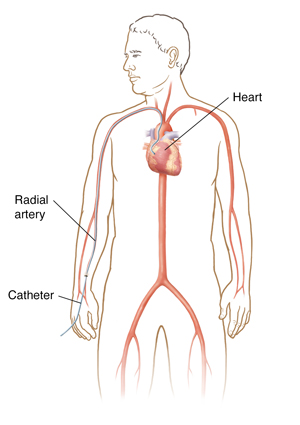Understanding Transradial Cardiac Catheterization
Cardiac catheterization (cardiac cath) is a common, non-surgical procedure. During the procedure, your doctor will insert a long, thin tube (catheter) into an artery and move it up into your heart. Transradial means the catheter is inserted into an artery in the wrist (the radial artery) rather than the groin (the femoral artery). This procedure can be used to diagnose and treat certain heart problems.

Why do I need a transradial cardiac cath?
You may need a cardiac cath if signs indicate a problem with your heart. These may include:
-
Symptoms of chest pain, tightness, or heaviness (known as angina). This is a common symptom of blocked heart arteries, known as coronary artery disease.
-
Symptoms of weakness, dizziness, trouble breathing, or swollen legs or feet. These may be symptoms of a problem with a heart valve or the heart muscle.
-
Other test results show heart problems. Tests may include stress tests, heart scans, and echocardiography.
During a cardiac cath, your doctor can see the condition of the coronary arteries and heart valves. They can also check how well the heart pumps and the flow of blood through the heart. Your doctor can also measure pressures and take blood samples. And, if needed, they can open blocked arteries. This can help reduce symptoms of angina.
Cardiac cath is often done using a catheter inserted into an artery in the groin. During transradial cardiac cath, the catheter is inserted into an artery in the wrist. This can mean less bleeding and a faster recovery. Some people may have blockages in the groin arteries as well as in the heart arteries, making it hard to reach the heart. The transradial approach can be used to get around this problem.
What happens during a transradial cardiac cath?
The procedure is done in the hospital or a surgery center. First, an IV line is put in your arm or hand to deliver fluids and medicines. You will likely be given medicine to relax you and make you drowsy. When the procedure starts:
-
You lie on an X-ray table.
-
The skin over the insertion site in your wrist is numbed.
-
The doctor makes a tiny puncture or incision into the artery in the wrist. They then insert a catheter and threads it through the blood vessel into your heart.
-
The doctor may inject a contrast fluid through the catheter into the arteries. This fluid makes the arteries show up better on X-rays.
-
Tests may be done to check the condition of your heart and arteries. If needed, the doctor can clear blockages in the arteries or do other repairs.
-
When the doctor is finished, they will remove the catheter and put pressure on the site to prevent bleeding. They could use a special device to reduce how long the pressure needs to be on. Or they could use an inflatable band to keep pressure on the site. Nursing staff will gradually reduce the pressure in the band after your procedure.
-
You will stay for a time to recover, and then go home. If this was an emergency procedure, you will likely stay in the hospital at least overnight.
What are the risks of transradial cardiac cath?
These include:
-
Bleeding, bruising, infection, or blood clots
-
Damage to the radial artery that may cause injury to the hand
-
Nerve damage to the hand
-
Allergic reaction to the contrast fluid
-
Abnormal heartbeat (arrhythmia)
-
Damage to blood vessels or tissues
-
Kidney damage or failure
-
The need for emergency heart surgery
-
Heart attack, stroke, or death
Online Medical Reviewer:
Callie Tayrien RN MSN
Online Medical Reviewer:
Stacey Wojcik MBA BSN RN
Online Medical Reviewer:
Steven Kang MD
Date Last Reviewed:
2/1/2022
© 2000-2024 The StayWell Company, LLC. All rights reserved. This information is not intended as a substitute for professional medical care. Always follow your healthcare professional's instructions.